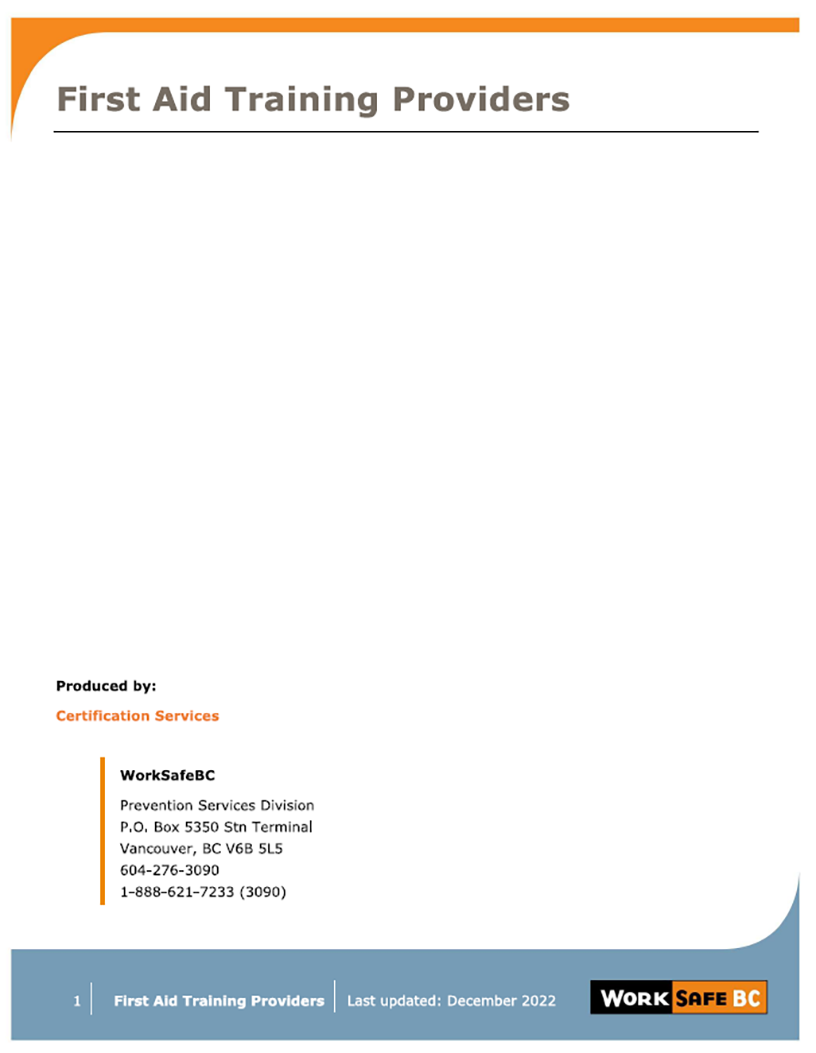First aid requirements
Employers are responsible for first aid in the workplace, ensuring that injured workers can receive prompt and appropriate treatment and, if needed, be transported to medical aid without delay.
To determine the first aid needs of your workplace, first you'll need to do an assessment. Then, you can review the findings and take the necessary steps to put effective first aid procedures in place.
New first aid requirements in effect
Amendments to the Occupational Health and Safety Regulation relating to occupational first aid took effect November 1, 2024. To assist employers in implementing these new requirements, the following resources are available:
- Backgrounder: Occupational first aid regulatory changes
- Changes to occupational first aid requirements: Frequently asked questions
- Workplace First Aid (video series)
See the amended sections of the OHS Regulation and the corresponding OHS Guidelines.
- Conducting a first aid assessment
- Developing first aid procedures
- Maintaining first aid records
- Resources
Conducting a first aid assessment
To determine an adequate and appropriate level of first aid coverage, the first step is to conduct and document a first aid assessment in consultation with workers. The assessment will help you determine the minimum level of first aid you need at your workplace.
The steps in a first aid assessment are outlined here. You can also use the First aid assessment worksheet to conduct and document your assessment.
Steps to first aid assessment
-
1
Identify the number of workers
First aid coverage must be based on the maximum number of workers present at each workplace. If you have multiple workplaces, you may need to complete an assessment for each location.
-
2
Identify your workplace hazard rating
Your minimum required first aid services are also determined by the hazard rating assigned to your workplace. You can find your rating on the classification unit description sent out every year or in this resource. (If workers will be doing work at a separate location that poses a greater risk than your assigned rating, you may need to use a higher hazard rating. See OHS Guideline G3.16 for more information.)
-
3
Determine if your workplace is remote or less accessible
The level of first aid service you need changes if your workplaces is less accessible and/or a BCEHS ambulance would normally take more than 30 minutes to reach your workplace.
-
4
Determine the required first aid services for your workplace
Refer to Schedule 3-A in the OHS Regulation to determine the minimum first aid equipment, supplies, facilities, and attendants you need.
If your workplace has unique hazards or risks, you may need to have additional first aid services to ensure injured workers will receive prompt and appropriate first aid and transport to medical care. See OHS Guideline G3.16 for more information.
-
5
Review your assessment
Review your assessment annually, or when there is a significant change in operations.
If you have a joint health and safety committee or worker health and safety representative, you must involve them when you conduct your assessment. If your workplace is smaller and you don’t have a joint committee or worker representative, look for ways to involve workers in the assessment during safety meetings or pre-job safety analyses.
Developing first aid procedures
You are responsible for keeping up-to-date written first aid procedures at your workplace. Your procedures must include:
- The first aid equipment, supplies, facilities, attendants, and services available
- The location of first aid
- How to call for first aid, and how the attendant is to respond
- Who is to call for transportation of injured workers to medical aid, and method of transportation including routes in and out of the workplace
- Any barriers to first aid and how injured workers will be accessed and moved if those barriers exist
- The authority of first aid attendants over the treatment of injured workers
- The responsibility of employers to report injuries to WorkSafeBC
Once you have developed your first aid procedures:
- Conduct a drill at least once a year or whenever your procedures change significantly. This drill should test the effectiveness of your procedures, including how well your communication system works and the ability of first aid attendants to respond. Drills also help you check your workers’ awareness of how to call for first aid and will determine if your first aid services are adequate to deal with injuries and illnesses most likely to happen in your workplace. OHS Guideline G3.17(4) contains more information about conducting drills.
- Consider how you will maintain your system for managing the first aid services at your workplace and who will be responsible for this task. This includes ensuring that required first aid attendants, supplies, facilities, and equipment are always available.
Maintaining first aid records
As an employer, you must maintain proper first aid records and documents. You're also responsible for determining who can access those records.
Your responsibility involves:
- Recording all reported or treated injuries and exposures that take place at your workplace
- Keeping records and documents for at least three years
- Limiting access to records and documents to only those with a need to review the records
For more details on acceptable record-keeping and access, see OHS Guideline G3.19.
Highlights:
- New first aid requirements now in effect Published on: November 01, 2024
- New videos: Workplace first aid requirements Published on: October 28, 2024
- Occupational first aid: Last update before regulation changes Published on: October 25, 2024




